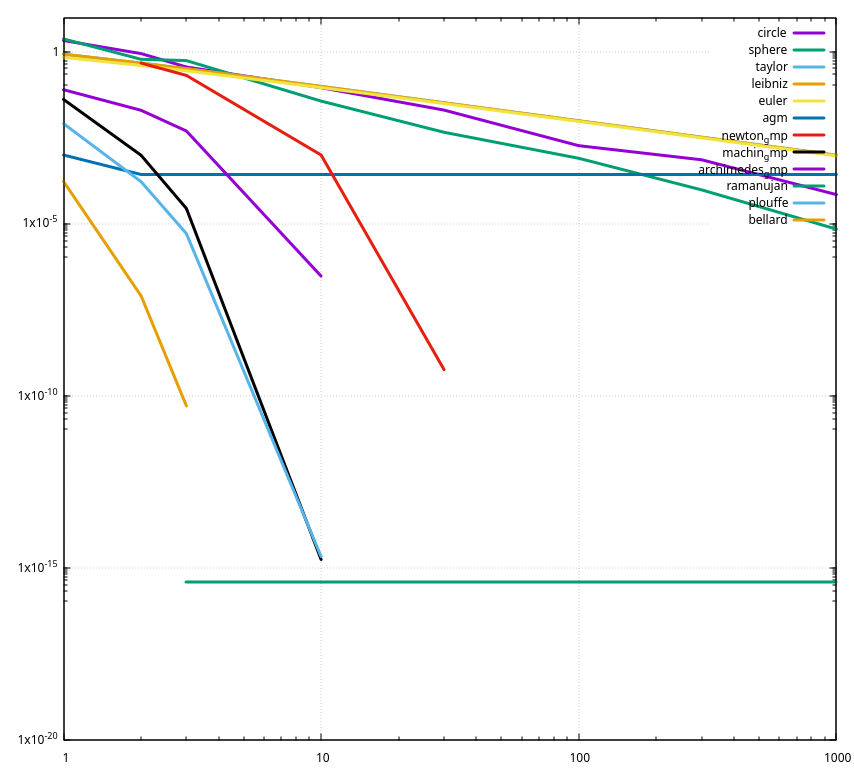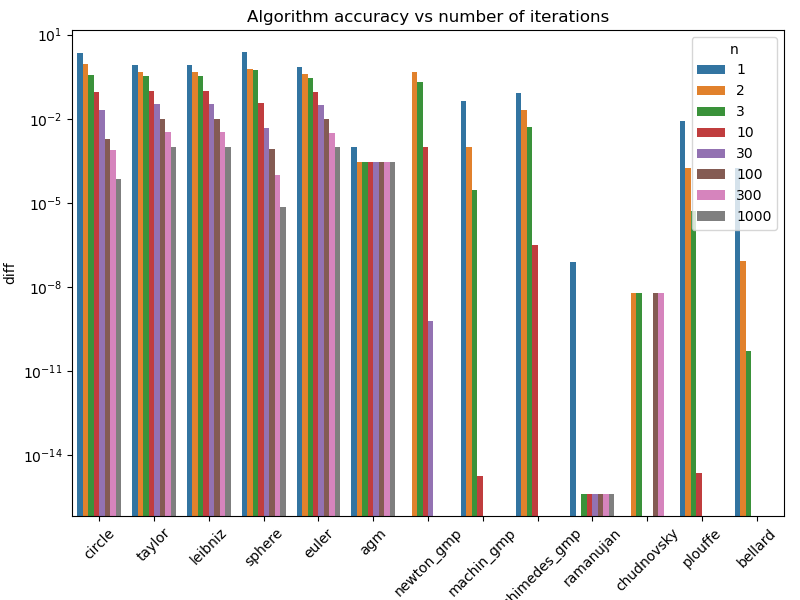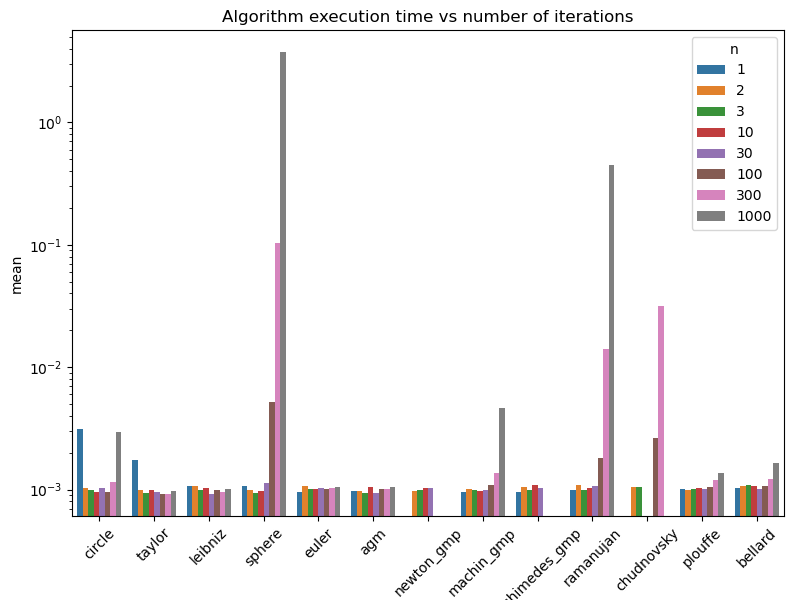Pi computation algorithms (2)
Date: 2025-08-14
We’ve seen multiple algorithms to compute approximations of in a previous article1. Once we know they all work, we can compare them, making sure to run them on the same machine within the same conditions.
As previously, the code is publicly available2 under CC BY-NC license.
Getting data
Convergence
One important thing is to see how long an algorithm takes to converge, and make sure they converge. This needs to take the duration of each iteration of loops, as well as the number of iterations.
First, we can simply run our code, sweeping for different iteration numbers, and types of algorithms3:
for algo in circle taylor leibniz sphere euler agm newton_gmp \
machin_gmp archimedes_gmp ramanujan chudnovsky plouffe bellard;
do for n in 1 2 3 10 30 100 300 1000;
do ./pi $algo $n;
done;
done > benchmarkWe also need to make the file less human-readable and more machine-readable, to something similar to CSV4:
sed -i 's/\,\titerations\:\ /\t/g' benchmark
sed -i 's/,\tpi\ \=\ /\t/g' benchmark
sed -i 's/,\terr\ = /\t/g' benchmarkExecution times
We can compare execution times:
hyperfine --export-json benchmark.json -N -r 10 -w 1 -L algo circle,\
taylor,leibniz,sphere,euler,agm,newton,newton_gmp,machin,machin_gmp,\
archimedes,archimedes_gmp,ramanujan,chudnovsky,plouffe,bellard \
-L n 1,2,3,10,30,100,300,1000 "./pi {algo} {n}" -iHyperfine returns a JSON file that’s completely different than the CSV file we built. Having both execution times and accuracy in a single file would be nicer.
We can do that using jq wrapped around some bash
code:
rm benchmark2.json;
for algo in circle taylor leibniz sphere euler agm newton_gmp \
machin_gmp archimedes_gmp ramanujan chudnovsky plouffe bellard;
do for n in 1 2 3 10 30 100 300 1000;
do pi=$(grep ^$algo$'\t'${n}$'\t' benchmark | awk '{ print $3}');
diff=$(grep ^$algo$'\t'${n}$'\t' benchmark | awk '{ print $4}');
echo $(cat benchmark.json |jq -r ".results[] | \
select(.parameters.n == \"$n\" and .parameters.algo == \"$algo\") | \
.pi="$pi" |.diff="$diff"")$',' >> benchmark2.json;
# match parameters.n and parameters.algo from the json file with $n
# and $algo from the csv file, adds $pi and $diff from the CSV file,
# adds a comma and write to benchmark2.json
done;
done;
sed -i '1s/^/{"results": [\n/' benchmark2.json; # adds a file header
sed -i '/^,$/d' benchmark2.json; # remove commas from blank lines
truncate -s -2 benchmark2.json # removes the last comma and \n
echo "\n]}" >> benchmark2.json # closes brackets at the end of the fileThis builds a new JSON file based on the content of the old JSON and CSV files.
Plots
We can simply display the content of the CSV file with a line plot:

This shows everything, although it’s not easy to read.
Instead, we can build a Python script to display the data we collected into the JSON file. This gives barplots showing the execution time and the accuracy relative to the iteration number for each algorithm.


Both informations are interesting, but what’s important is actually the compromise between execution time and accuracy.
To address that, we can compute a figure of merit by multiplying the execution time and the accuracy, without any coefficients. In this case, a smaller number means that an algorithm is both quick and accurate.

First conclusions
That enables us rate algorithms, or actually their implementation, based a few things:
- Missing data:
- Failed computation
- Accuracy better than 64-bit numbers
- Convergence that stops: accuracy limited by implementation
- Convergence speed
- Increasing figure of merit after a number of iteration:
- Stalled algorithm
- Accuracy limited by implementation
Algorithm ratings
| Algorithm | Accuracy | Figure of merit | Stops converging | Accuracy limited by 64-bit floats |
|---|---|---|---|---|
| Circle | Poor | Poor | - | - |
| Sphere | Average | Poor | - | - |
| Taylor | Poor | Poor | - | - |
| Machin | Good | Good | - | - |
| Leibniz | Poor | Poor | - | - |
| Euler | Poor | Poor | - | - |
| Gauss-AGM | Average | Average | Y | - |
| Newton | Good | Good | - | - |
| Archimedes | Average | Average | - | - |
| Ramanujan | Very Good | Very Good | Y | Y |
| Chudnovsky | Good | Average | Y | |
| Plouffe | Very Good | Very Good | Y | Y |
| Bellard | Very Good | Very Good | Y | Y |
Algorithms shown in bold can be implemented again for better results.
Algorithms shown in italic have been tested with gmp_printf() to get rid of the 64-bit float limit.
- ← Previous page
Débimètre Bosch HFM - Next page →
cms
Electronics Électronique puissance semiconducteur semiconductors power Hardware CPE INSA Xavier Bourgeois
 RSS - Blog
RSS - Blog